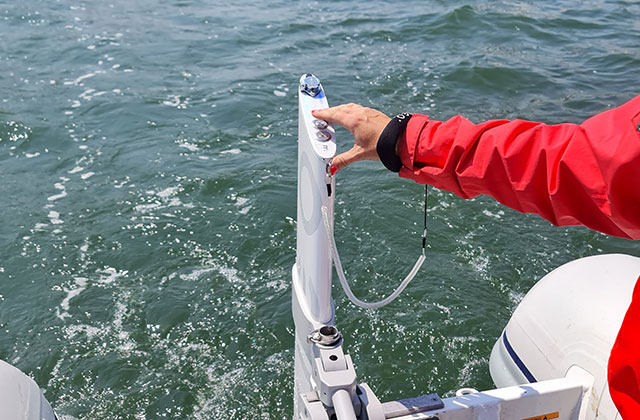Designed from the outset to break away from traditional designs for outboard motors, Remigo have created an electrified dinghy rudder. Tech Editor Fox Morgan headed out into Southampton water to give it a thorough test.
Remigo One Electric Outboard Review

Remigo One
Designed from the outset to break away from all traditional outboard motor styles, the Remigo One looks very much like a rudder. The battery is encapsulated within the rudder area with a smart sleek powder coated finish.
The mount is no less smart as well, with a simple pin and latch utilised in the dual purpose handle.
The controls are all on top of the unit and the handle is simply a tiller or handle depending on which way you have it facing.
There’s no twist grip here keeping moving parts to a minimum. This means that there’s fewer things to wear out or go wrong.
They claim the battery life of this is 10 years under real world conditions, but a theoretical lifespan of 30 years under perfect conditions. At the end of the battery life the outboard can be returned for a new battery to be fitted. Hopefully by the time these batteries start to fail there’s a bigger network of approved or skilled electric motor mechanics or sparkies available and I guess by then we’ll all be riding around on hover boards powered by nuclear fusion cells no bigger than my little finger… or maybe lithium batteries will be even more efficient and who knows where we will be in 10 years. Either way, it’s an impressive claim for the battery life.
In use the motor was highly intuitive and took precisely one push of the power button to feel entirely familiar with it. Though which button you’ve actually pressed will be unknown unless you look at where you’re pressing. I’d like to see some form of touch texture, even something as simple as a dimpled go faster button would be sufficient to avoid having to look back at which button I’m pressing.
Motoring along I used a Highfield aluminium rib as my test boat, which is a little bit heavy for a small motor like this. In a smaller dinghy with an inflatable floor/keel, this thing would zip along. As it was, even in the heavy-weight Highfield I got a good turn of speed up though it was never a remote possibility it would bring this on to the plane (10hp is required for that). The Remigo outboard gives roughly 3hp but it feels so much more finely responsive than any petrol powered unit I’ve used. At half power I could motor up and down Southampton water to and from my mooring for about 6 hours. At full power (roughly 5kts) I’d get about an hour out of it, or about 5 nautical miles.

Flipping the Remigo into reverse was fast, at the press of both buttons together, I can stop and then reverse the motor in 2 seconds.
Turning off the power and using the outboard as a passive rudder was immensely satisfying. It allowed really smooth control for bringing the dinghy alongside the pontoon or bathing platform. It’s so useful in fact, it makes me wonder why it has taken so long for an outboard manufacturer to do this.
Charging can be done with a variety of chargers, but is generally going to take a few hours if you really flatten the battery. The trick to using electric though is to just top up little and often.
Given how light this outboard is, it’s not difficult to quickly unclip it, dry it off and put it on a bunk below plugged into a DC charger and trickle charge it for a bit. Electric outboards are not going to spill oil all over the place or leave a stink of petrol lingering in your cabin if that’s where you stow it. You can also stow it in any position you like. There’s no risk of flooding a chamber or needing to dry a spark plug off.
The bags that Remigo can supply for their outboards are all made from recycled lorry curtain sides. These are hardwearing and a little rough around the edges in terms of finish ( they’re all thoroughly cleaned and the material in very good condition), but I suspect they are a work in progress and might evolve a little as time goes by. I liked it more because of this roughness. It felt genuinely recycled and looking under some of the seams, some old lorry artwork was hidden but still there. No two bags will be exactly the same.
For simplicity and intuitive controls and use I am giving this a solid 5 out of 5 stars.
For power delivery, battery, screen and controls 4.5 out of 5
For eco credentials 5 out of 5
Find a dealer at Silent Yachting
Specifications:
Outboard weight in kg – 12
Total weight in kg (bracket included) – 14.5
Shaft length – stepless adjustment up to 800 mm / 15-30 inch eq.
Maximum propeller speed in rpm – 1000
Control – smart 2-button control
Steering – lockable
Tilting – manual with grounding protection
Trim – manual, 4 positions
Reverse – yes
Dimensions h x w x d – 1250 mm x 295 mm x 90 mm
Input power in watts – 1000
Motor type – brushless DC
Static thrust in kg – 30
Comparable petrol outboard – 3 HP
Battery – integrated 1085 Wh Li-Ion
Nominal voltage – 36 V
Charging time 100 – 240v – 6h (standard charger – included)
V charging time 100 – 240v – 3h (fast charger – optional)
V charging time 12 – 24V – 10 – 12h (DC charger – optional)



